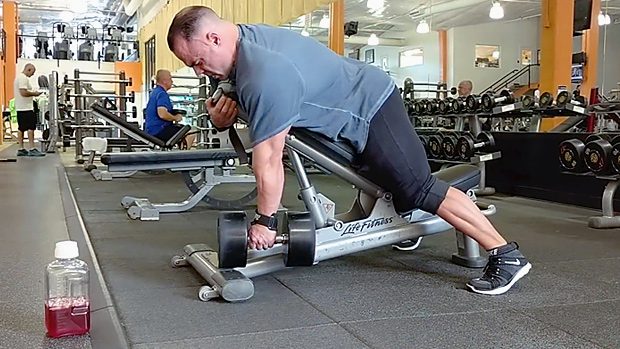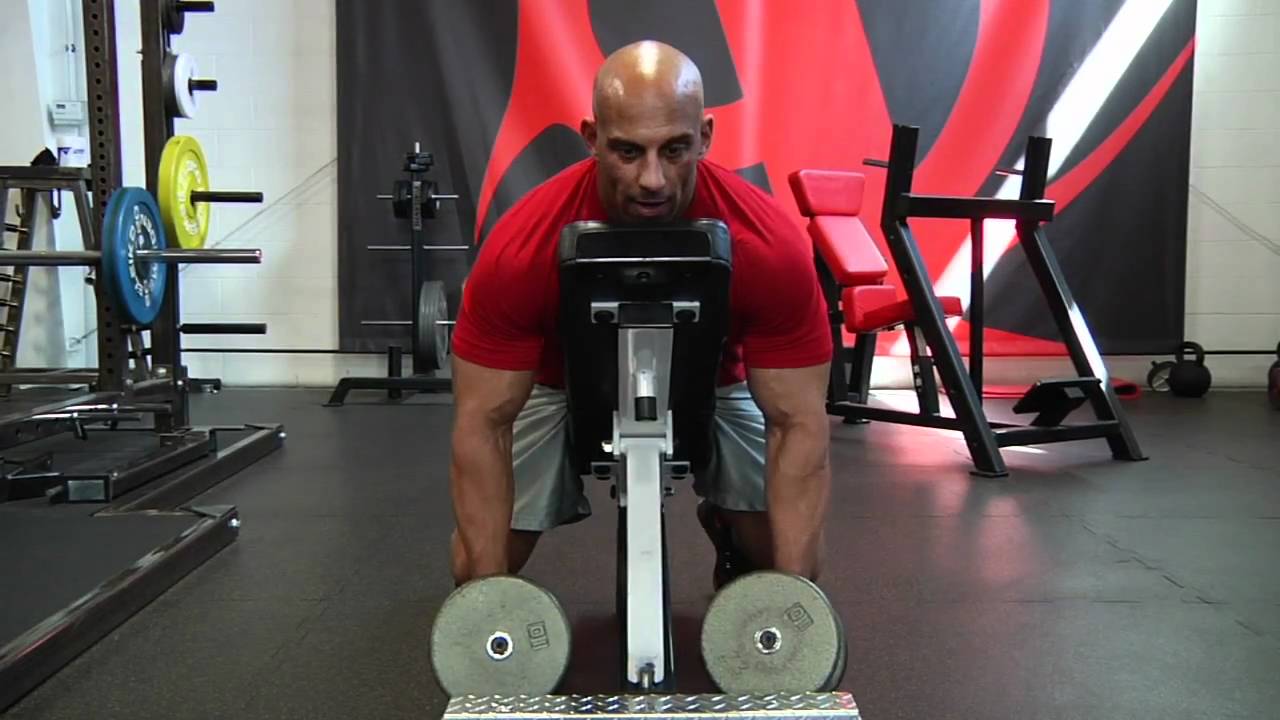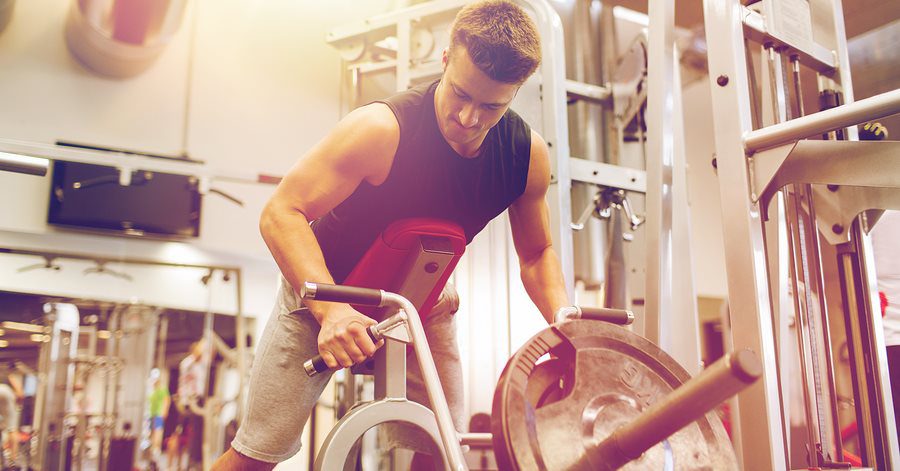Having a wide, strong, back is one of the most common goals amongst bodybuilders and regular gym goers alike.
While there are several methods of building a strong back, the most common exercise is the row.
The row is a blanket term that can cover numerous different exercises with one common theme, they all involve some form of rowing motion.
Unfortunately, like many other exercises, there is some degree of risk involved if the movement is performed in an incorrect fashion.
Since rows require a high degree of flexibility and mobility, they must be done properly to avoid risk of serious injury.
Keeping a straight back and neutral spine is imperative for long term success in the gym while doing all exercises. The bad news is that even with perfect form and controlled movements, the risk of injury still persists.
So you WANT a bigger stronger back BUT also want to avoid injury you say? Look no further than the chest supported row.
Bent over rows are often seen as the grand daddy compound movement of back exercises, but can put your spine in a compromised position. Over years and years of lifting this may spell disaster for your discs.
One good way to limit this risk is by performing exercises that are chest supported yet still isolate the various back muscles.
Chest supported rows provide all the isolation benefits of a bent over row but without the risk for potential injury.
Setting up for the Chest Supported Row
Barbell Chest Supported Row

The chest supported barbell row does not require a ton of equipment but must be setup properly to optimize muscle hypertrophy. The following items are needed for setup:
- Olympic bar
- Weight plates (choose a weight that is light to moderate to begin with)
- Adjustable bench
- Squat Rack with hooks facing outwards (optional though useful to begin the movement)
Once you have all the equipment that you need, begin the setup by performing the following steps:
- Begin by setting up your incline bench near the squat rack at a moderate incline angle of approximately 45 degrees. Setting the incline too high will cause awkward positioning and setting it too low may limit your range of motion thereby decreasing the effectiveness of the exercise.
- Place the hooks on the outside of the squat rack at a height that is comfortable for reaching at arms length. (Note: if you do not have a squat/power rack you can still perform the exercise if another person is able to assist you in lifting the barbell to begin the movement).
- Next, move the incline bench to the squat rack so that the bench is positioned directly over the center of the barbell. Your shoulders should line up directly with the bar.
- Lie down on the bench with your chest firmly against it.
- Keep your feet on the ground or straddle the bench tightly to get into position.
- Grab the bar with whatever grip is preferable whether it be overhand or underhand. Switching up the grip position is one method of changing up your workouts.
- Begin the rowing motion by grabbing the barbell and moving the weight up and down in a steady and controlled manner. (Note: form is much more important than weight so control the weight versus swinging it back and forth with weak form.)
- For muscle hypertrophy try to keep the rep ranges within 6 to 12 reps. Try not to go too heavy during the movement and increase weight gradually if needed.
Related: The Floor Press – Benefits, Technique, and Muscles Worked
Dumbbell Chest Supported Row

Performing a dumbbell chest supported row is similar to a barbell chest supported row with only a few slight tweaks and adjustments.
First off, a squat rack/power rack is not needed so you can place the dumbbells on the ground and pick them up to start the movement. Alternatively, if you cannot reach the dumbbells having another person assist you in beginning the movement is helpful.
Otherwise, everything remains the same when performing the dumbbell chest supported row. One benefit of the dumbbell chest supported row is that there are more options for grip variations. Dumbbells can be used with a overhand, underhand, or neutral grip. Switching the grip position can be useful for keeping workouts fresh and challenging.
Read Also: Rogue Ohio Power Bar Review – A comprehensive buyer’s guide
Chest Supported Row Benefits

When doing a back workout, the options are virtually limitless when it comes to the choices of exercises available at your disposal.
While some back exercises are great for building muscle, they may also have negative risks associated with them.
Chest supported rows have several benefits that make them one of the best back exercises to incorporate into your next workout routine.
- Low Chance of Injury: Exercises such as T-Bar rows or Bent Over Rows are great for building muscle but compromise the safety of your back while performing them. By performing a similar movement with the support of a bench against your chest, you are able to receive all the benefits of the exercise while reducing the potential risk of injury.
- Limited Equipment Needed: Unlike some back exercises, no complex machines or equipment is needed. Most gyms have a rack, weights, and a bench which is all that is needed to perform the movement.
- Great for Isolating Back Muscles: Other back exercises such as bent over rows activate secondary muscles such as the glutes and hamstrings. The chest supported row keeps your spine in a neutral position thereby limiting the amount of other muscles used in the movement.
- Perfect Alternative Exercise for those with Injuries: Many people have a history of injuries when it comes to performing different back exercises. Individuals with low back problems or prior surgeries are unable to do movements such as deadlifts, bent over rows, or T-Bar rows. However, a chest supported row can be done by people of all ages regardless of past history of injury.
- Great Way to Learn Form: Often times beginners injure themselves early on due to improper mechanics or lack of knowledge. By first learning the proper way to do a chest supported row, you may avoid injury in the future if you decide to switch to bent over rows. Think of it as learning to ride a bike with training wheels before taking them off.
Muscles Worked with a Chest Supported Row

Many people think of the chest supported row strictly as a back exercise. This is a true, yet somewhat generic generalization.
Although people think of the back as one large muscle, the truth of the matter is there are several primary and secondary muscles being worked during this particular movement.
Some of the muscles worked in the movement include:
- Latissimus dorsi (Lats): When people do a “back” day the most common muscle they believe they are working is the lats. The lats make up a large portion of the back and aid in giving a wide appearance when fully developed.
- Rhomboids: These muscles are smaller but aide in the retraction of the scapula. Generally this a secondary back muscle that is activated during the chest supported row.
- Biceps: Biceps are activated as a secondary muscle group during the chest supported row. The main reason biceps are often worked on back day is due to the fact that most compound back movements also activate the biceps as well.
- Trapezius (Traps): A lot of people tend to believe that the only way to work the traps is by performing shrugs. This fact has been proven to be false, as the traps are also engaged during many back movements including the chest supported row.
- Teres Major and Minor: Never heard of this particular muscle group? Chances are you’re not alone. But just because you’ve never heard of it doesn’t mean it’s not there. Many people would be hard pressed to point out where this muscle group lies on a standard anatomy chart. However, don’t let that fool you as this muscle is crucial for adducting and rotating the arm.
Chest Supported Row Alternative

Chest supported rows are not the only exercise that can be performed if struggling with lower back pain or issues.
There are several other exercises that are just as effective as the chest supported row. One such exercise is the chest supported T-Bar row.
Many gyms have some form of the chest supported T-Bar row. The stationary design of the bar staying attached helps to limit back flexion and prevent lower back injury.
Generally, the chest support is adjustable so you can find a proper height that will allow for optimum range of motion.
Another advantage of the T-Bar row machine is that it will usually have multiple grips which allows for variation workout by workout.
Longevity in the gym is increased by limiting the risk of injuries. By performing the chest supported row or chest supported T-Bar row you will be able to stay healthier and perform better in the gym for life.
Chest Supported Row vs. Barbell Row

Fitness “experts” and hardcore bodybuilders have differing beliefs on the proper ways to perform certain exercises.
While experts will argue one exercise is absolutely necessary for growth and development, one individual must take into account their own unique goals and weaknesses.
Bent over rows may activate more muscle groups but they also have a much higher degree of injury as well.
Performing a bent over row properly requires having a correct hip hinge while keeping a neutral spine.
While some other muscle groups such as the multifidus and spinal erectors may be activated during a bent over row, they also can increase the rate of back injuries as well.
Understanding your body and preventing injury is much more important than listening to “experts” that think they know what is best for everyone.
Bent over rows are considered a compound movement that can activate several muscles but should only be performed with moderate weight using perfect form.
If there is any prior history of back problems or injuries, it is imperative that chest supported rows be considered as a viable alternative exercise.
Even if one exercise is slightly more optimal than another, it is key to understand your body and limitations.
Conclusion
If you have never explored the possibility of incorporating chest supported rows into your back routine, feel free to try them during your next workout.
Regardless of past injury history, the chest supported row is a great way to isolate the back muscles from the rest of the body.
With a few simple pieces of equipment you too can use chest supported rows to grow your back to its full potential.

